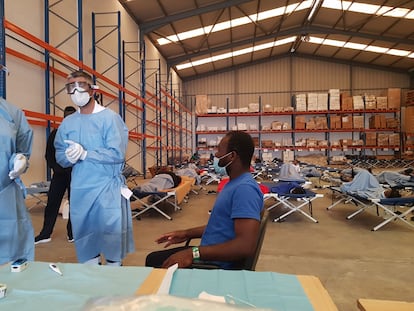Spanish government to open new shelters in Canary Islands amid surge in migrant arrivals
More than 4,000 people have arrived in the archipelago since the beginning of the year, a sevenfold rise on the same period in 2019

The Spanish government will open its own migrant centers in the Canary Islands to address a surge of arrivals to the archipelago, according to sources from the secretary of state for migration. The Canary Islands regional government and NGO groups have been demanding the government open its own facilities for years. This demand has taken on greater urgency in recent times due to the spike in arrivals and the difficulties posed by the coronavirus pandemic.
The accommodation conditions are worse than at refugee camps in countries like South Sudan, Angola and IraqAbián Montesdeoca, pediatrician
Increased border controls in northern Morocco have been pushing the migration routes to the Atlantic side, where the nearest of the Canary Islands lies around 95 kilometers west of the Moroccan coast. As a result of the rising number of arrivals, the government delegation in the region has been forced to improvise accommodation options for migrants. These have broadly failed to meet basic standards, with migrants staying overnight at docks, in industrial warehouses, in Canarian wrestling facilities and in tourist complexes during the last few weeks. For months, both regional and local authorities have been using their own facilities to accommodate the migrant arrivals.
But it will still be months before the new centers open. “Due to the processing times required, temporary resources will be sent to allow hundreds of people to be homed in dignified conditions,” said the same sources, who defended the work of the secretary of state for migration. “In October 2019, the Canary Islands had fewer than 100 spots at shelters, now there are 2,000, 600 of which we have created in the last two weeks,” they said.
The central government has been looking at possible sites for the new migrant centers for months. One option under consideration is to use abandoned Defense Ministry facilities, an idea backed on Monday by Ángel Víctor Torres, the leader of the Canary Island regional government.
Arrivals
More than 4,000 migrants have arrived in the Canary Islands since the beginning of the year. This figure is seven times higher with respect to the same period in 2019. On Tuesday alone, 160 people on six different boats reached the shores of Gran Canaria and Tenerife. The last of these boats, located five miles south off the coast of Tenerife, was carrying a body, according to sources from Spain’s Maritime Rescue services. The arrivals on Tuesday come after more than 200 people reached the archipelago last week on 11 different boats.

The rising number of arrivals, together with the suspension of transfers to the Spanish peninsula, has pushed migrant centers to the breaking point. The situation, which is especially dire in Gran Canaria, has led migrants to be housed in “deplorable” and “inhuman” conditions, according to Abián Montesdeoca, a pediatrician with the regional healthcare service. Since March, Montesdeoca has been leading a special team treating disease and following the health of migrant children. “We are worse than ever,” he says, explaining that the facilities are not cleaned, often lack showers and bathrooms, have poor ventilation, where social distancing measures are nonexistent and there is no space to treat patients or for medical consultations. In some cases, there are trash containers within the warehouse, and adults and children are forced to sleep on the floor.
“The accommodation conditions are worse than at refugee camps in countries like South Sudan, Angola and Iraq, as one of our colleagues has confirmed,” he says. Montesdeoca adds that in these conditions it is impossible to maintain any kind of coronavirus prevention measure, and those who contract the disease are not placed in quarantine but remain in the overcrowded facilities.
English version by Melissa Kitson.
Tu suscripción se está usando en otro dispositivo
¿Quieres añadir otro usuario a tu suscripción?
Si continúas leyendo en este dispositivo, no se podrá leer en el otro.
FlechaTu suscripción se está usando en otro dispositivo y solo puedes acceder a EL PAÍS desde un dispositivo a la vez.
Si quieres compartir tu cuenta, cambia tu suscripción a la modalidad Premium, así podrás añadir otro usuario. Cada uno accederá con su propia cuenta de email, lo que os permitirá personalizar vuestra experiencia en EL PAÍS.
¿Tienes una suscripción de empresa? Accede aquí para contratar más cuentas.
En el caso de no saber quién está usando tu cuenta, te recomendamos cambiar tu contraseña aquí.
Si decides continuar compartiendo tu cuenta, este mensaje se mostrará en tu dispositivo y en el de la otra persona que está usando tu cuenta de forma indefinida, afectando a tu experiencia de lectura. Puedes consultar aquí los términos y condiciones de la suscripción digital.
More information
At least 50 migrants drown trying to reach Spain’s Canary Islands
Spain’s Canary Islands struggling to cope with rise in migrant arrivals
Últimas noticias
Petro claims the ELN was the target of US attack in Venezuela
Maduro counterattacks Trump with rhetoric and announces downing of nine drug trafficking aircraft
‘Ecce Homo’: The miraculous disaster that made a small Spanish town famous
Return to sex testing at the Olympics: IOC edges closer to banning transgender women
Most viewed
- Sinaloa Cartel war is taking its toll on Los Chapitos
- Oona Chaplin: ‘I told James Cameron that I was living in a treehouse and starting a permaculture project with a friend’
- Reinhard Genzel, Nobel laureate in physics: ‘One-minute videos will never give you the truth’
- Why the price of coffee has skyrocketed: from Brazilian plantations to specialty coffee houses
- Silver prices are going crazy: This is what’s fueling the rally








































